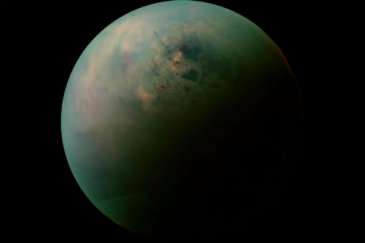On human timescales, things in the Solar System seem to be pretty set in place. Over cosmic timescales, it's all gradually falling apart. The planets are very, very slowly moving away from the Sun; and most of the moons are slowly moving away from their planets in a process called tidal acceleration.
The fact that Titan is slowly moving away from its planet - Saturn - is therefore not at all unusual. But astronomers have found something really surprising: Titan's outward migration is faster than expected - about 100 times faster.
This suggests that the peculiar moon formed much closer to the planet during the birth of the Solar System 4.5 billion years ago, and in the intervening years has migrated out to a distance of around 1.2 million kilometres (746,000 miles) from the planet.
This discovery suggests our understanding of tidal acceleration around Saturn has… a few gaps in it.
"Most prior work had predicted that moons like Titan or Jupiter's moon Callisto were formed at an orbital distance similar to where we see them now," explained theoretical astrophysicist Jim Fuller from the California Institute of Technology.
"This implies that the Saturnian moon system, and potentially its rings, have formed and evolved more dynamically than previously believed."
Key to the process of tidal acceleration is a phenomenon known as tidal friction. We can observe this very clearly on Earth. As the Moon moves around our planet, its gravitational pull causes the oceans (and to a lesser extent Earth itself) to deform and bulge, and then relax again.

This is why our oceans have rising and falling tides; but that constant deforming and relaxing converts some of Earth's rotational energy into frictional heat - in effect, it acts like a giant brake on the planet's rotation. Tidal friction is required to maintain that bulge, but because Earth rotates faster than the Moon's orbit, the bulge is always slightly ahead of the Moon.
The other thing the bulge does is distort Earth's gravitational field, which then exerts an additional tug on the Moon, accelerating it in its orbit. This additional energy is causing the Moon to gradually move away from us, at a rate of about 3.82 centimetres (1.5 inches) a year.
A similar interplay takes place between Titan and Saturn, but scientists thought that the effect would not be so pronounced. This is because Saturn is gaseous, a composition thought to generate less friction than Earth's oceans and rocks.
According to standard theories, Titan should be moving away from Saturn at a rate of just 0.1 centimetres per year.
Instead, two independent techniques have shown that Titan is moving away from Saturn at a rate of 11 centimetres per year - nearly three times the rate of our Moon's outward migration.
The techniques lean heavily on data achieved via the Cassini mission. The first is astrometry, which measures Titan's position relative to background stars. Cassini took measurements of this, which were added to historical observations dating back to 1886, to calculate Titan's changing position relative to Saturn over time.
The second technique was radiometry. Cassini had 10 close encounters with Titan between 2006 and 2016, monitored by the ground-based Deep Space Network. These were able to provide accurate measurements of the changes to Cassini's velocity due to Titan's gravity.
Analysis of these two sets of data revealed the stunning result.
"By using two completely independent data sets - astrometric and radiometric - and two different methods of analysis, we obtained results that are in full agreement," said astronomer Valéry Lainey, formerly of JPL and now of the Observatoire de Paris in France.
Although this contradicts some previous predictions, there is one theory that produces a faster Titan migration. In 2016, Fuller proposed that a mechanism seen in binary stars called resonance locking could be responsible for faster migration in the moons of gas giants.
Resonance locking is thought to happen when the gravitational force of the moon squeezes the planet, forcing it to oscillate strongly. This would dissipate a lot of tidal energy, giving the moon an extra kick that would increase its migration rate.
It's possible that Juno data could reveal a similar migration rate for Jupiter's moons, which would further validate the idea of resonance locking between a gas giant and its moons. It's all falling into place after all.
The research has been published in Nature Astronomy.
